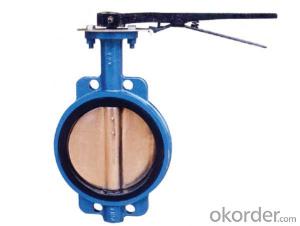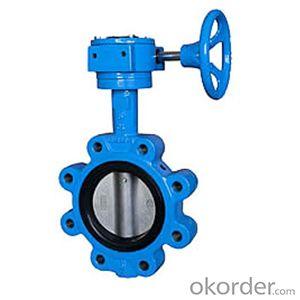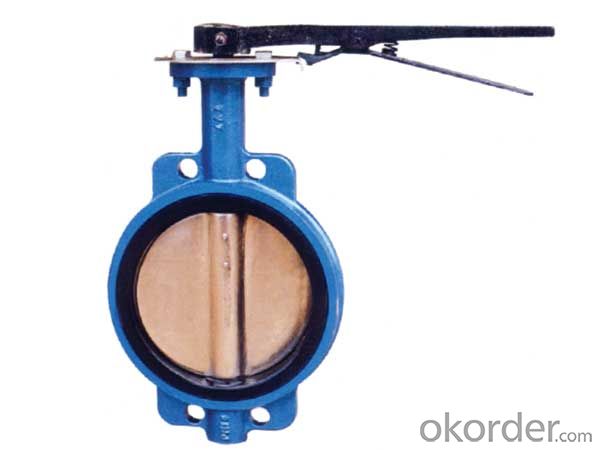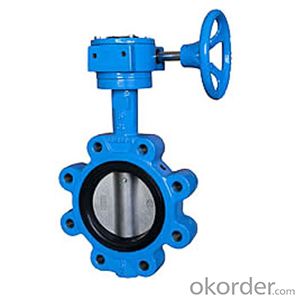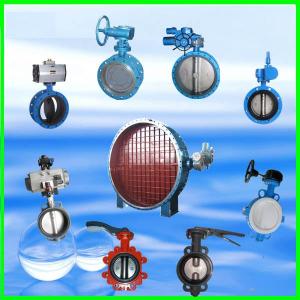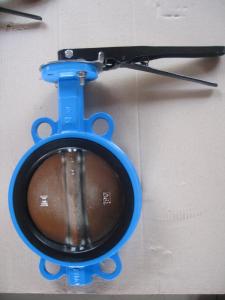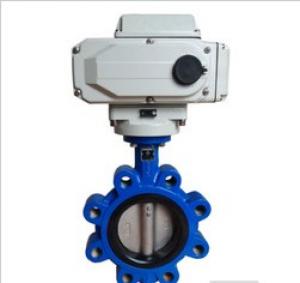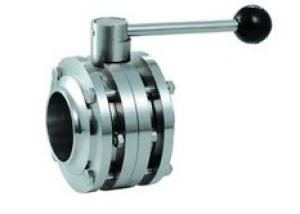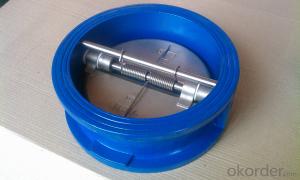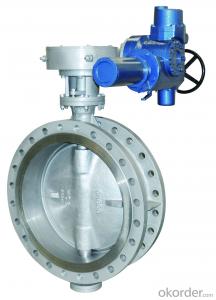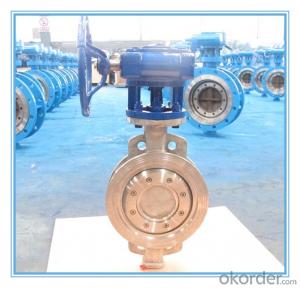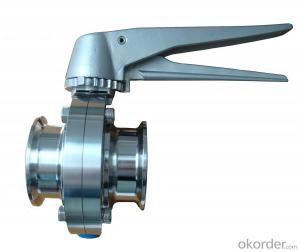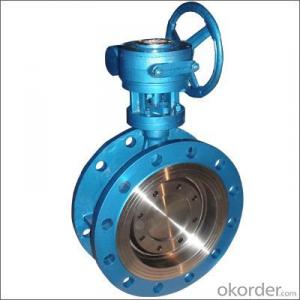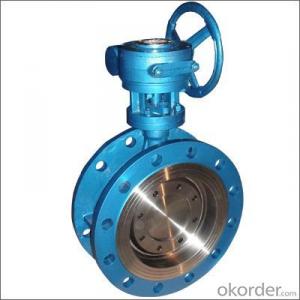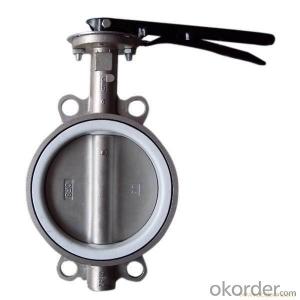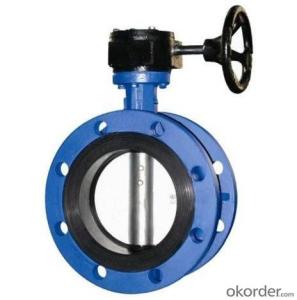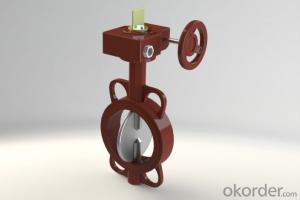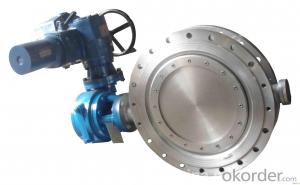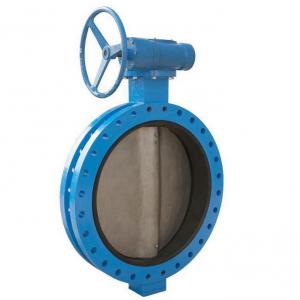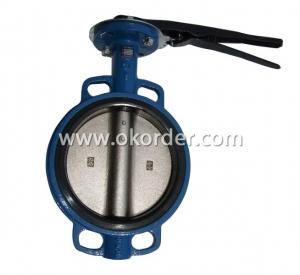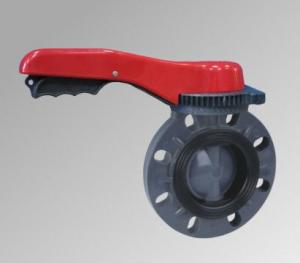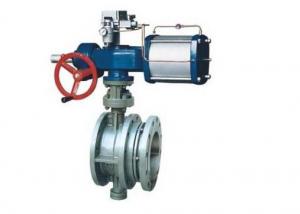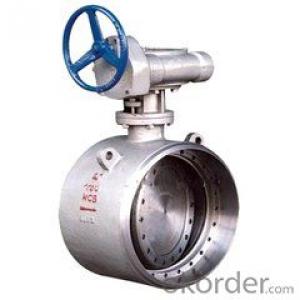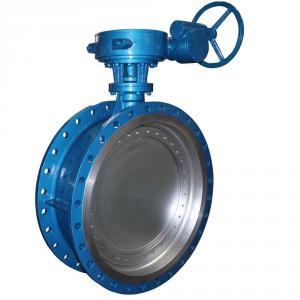Butterfly Valve Electric Wafer Lug Type Eccentric DN10
- Loading Port:
- China main port
- Payment Terms:
- TT OR LC
- Min Order Qty:
- 100 set
- Supply Capability:
- 80000 set/month
OKorder Service Pledge
OKorder Financial Service
You Might Also Like
1. Manual Wafer Butterfly Valve Description:
A butterfly valve consists of body ,stem ,disc , actuator (manual actuator, worm-gear actuator , aerodynamic actuator or electric actuator) , and wafer type butterfly valve can implement the process for turning on turning off and regulating the flow by the circumrotation of stem and disc that is droved by actuators.The disc is positioned in the center of the pipe, passing through the disc is a rod connected to an actuator on the outside of the valve. Rotating the actuator turns the disc either parallel or perpendicular to the flow. Unlike a ball valve, the disc is always present within the flow, therefore a pressure drop is always induced in the flow, regardless of valve position.
2.Main Features of the Manual Wafer Butterfly Valve
1. Small in size and light in weight, easy instillation and maintenance. It can be mounted wherever needed
2. Simple and compact construction, quick 90 degrees on-off operation
3. Minimized operating torque, energy saving
4. Flow curve teeing to straight line, excellent regulation performance
5. Long service life, standing the test of tens of thousands opening/closing operations
6. Bubbles-tight sealing with no leakage under the pressure test
7. Wide selection of materials, applicable to various mediums
Nominal bore mm 20 25 32 40 50 65 80 100 125 150 200
Valve core diameter mm 10 12 15 20 25 32 40 50 65 80 100 125 150 200
Rated flux coefficient Kv 1.2 2 3.2 5 8 12 20 32 50 80 120 200 280 450
Nominal pressure Mpa 1.6 4 6.4
Match DKJ actuator specification DKZ-4100 DKZ-4200 DKZ-4300 DKZ-5400 DKZ-5500
3. Manual Wafer Butterfly Valve Images:
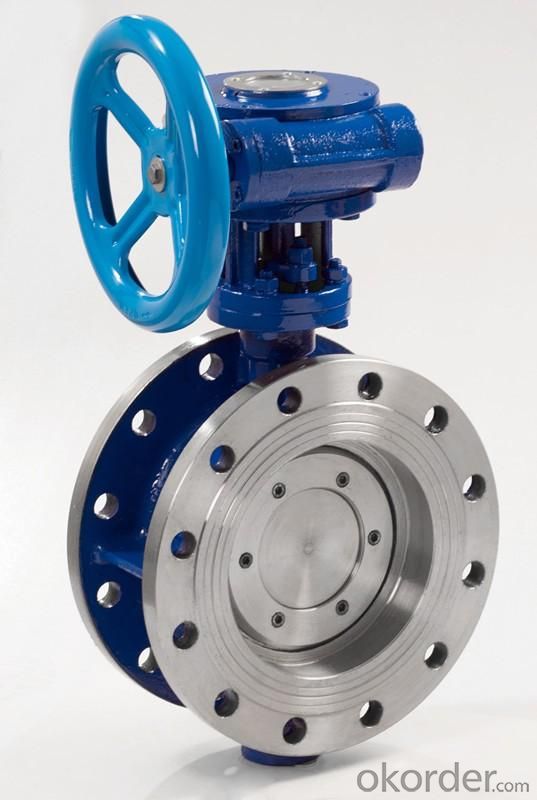
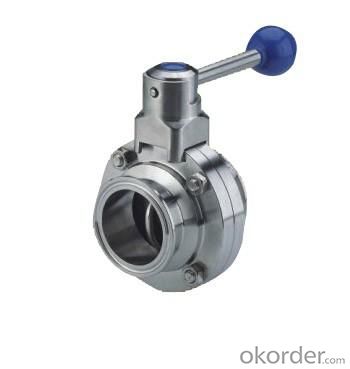
4.Manual Wafer Butterfly Valve Specification:
Disc: DI/ALB/Rubber lined Disc/1.2501/1.4529/CF8/Hastelloy Alloy/Monel
Stem: 410/416/304/431/17-4PH/316/monel
Seat: NBR/Hypalon/EPDM/Neoprene/NR/Wear-Resistant EPDM/Viton/Silicon/Heat-Resistant EPDM/White EPDM/EPDM(NSF)/PTFE
Suitable temperature: -10~120
Medium: Fresh water, sewage, sea water, air, vapor, food, medicine, oils, alkalis, salt etc.
Nominal Pressure: PN10/PN16
Working Temperature : -45 C centigrade-+200C centigrade
Suitable Mediums : Fresh water, Sewage, Sea water, Air, Oils, Acids, Alkalis, Salts, etc.
5.FAQ
1. What is manual wafer butterfly valve?
A: Wafer style is the more common of the two and is less expensive than the lug style. The wafer style butterfly valve is just about the standard. It ís so common that no one even bothers to use the word "wafer" when ordering a butterfly valve. It is taken for granted that if a butterfly valve is ordered, a wafer style will be received.
2. How about the Installation of the Wafer Style Butterfly Valve?
A: Butterfly valves are installed by inserting the valve between two flanges using bolts or studs and nuts to hold it all together. This type of installation, of course, makes it impossible to disconnect just one side of the piping system from the valve. That benefit is received using the lug style valve.
3. What is the working principle of manual wafer butterfly valve?
A: A butterfly valve is from a family of valves called quarter-turn valves. In operation, the valve is fully open or closed when the disc is rotated a quarter turn. The "butterfly" is a metal disc mounted on a rod. When the valve is closed, the disc is turned so that it completely blocks off the passageway. When the valve is fully open, the disc is rotated a quarter turn so that it allows an almost unrestricted passage of the fluid. The valve may also be opened incrementally to throttle flow.
- Q: Butterfly valve model D344H and D343 difference
- [1] D344H-10C DN400, D343H-10C DN400, to talk about the 2 types of butterfly valves in common: D on behalf of 3 Representatives is butterfly valve, turbine driven, 4 representative is in the middle of flange, representing 10 kg pressure, C is the representative of the valve material is cast steel, DN400 represents the valve diameter; say that there the difference of the 2 models, there is a place where there are differences, second means 4 of the first models is the new type sealing valve structure is variable eccentric, second of the second models of the 3 represents the structure of the valve is three eccentric, and three eccentric seal type variable eccentric in fact, is a meaning.Sealed three eccentric butterfly valve, sealed variable eccentric butterfly valve, corresponding to the central butterfly valve and sealed single eccentric butterfly valve.
- Q: What does butterfly valve nps12cl150d373f4-150lb stand for?
- NPS (Nominal, Pipe, Size) abbreviation. Refers to the connection (including flanged and welding end) of the nominal diameter, followed by a digital unit is American Standard inches, 12 inches.NPS12 labeling system.CL is the abbreviation for class, and LB150 means the pressure is 150 poundsD stands for butterfly valves3 is expressed in the form of a turbine drive7 means of connection: to clip3 means sealing: 3 eccentricF4: the sealing material is PTFE
- Q: How is the lug butterfly valve connected to the flange?
- Lug type butterfly valve is also called a single flange type, that is, with a flange on the valve body, usually installed at the end of the pipe, and even the method is 1: double bolt lock on the valve body 2: into the flange 3: lock nut
- Q: Butterfly valve model D373F-16C, ask God answers
- D butterfly valve, 3 turbo rotating, 7 pairs clip type, 3 eccentric F PTFE seal, 16 nominal pressure 1.6MPA, C valve body material, carbon steel
- Q: For example, the arrow above is from left to right, and the direction of my current is from right to left. Is that ok? I have a diameter of 700 of the hard seal butterfly valve is so installed, but it will leak water, it will not leak, very serious
- From the above example, it can be concluded that the arrow direction of the butterfly valve body refers to the direction of the pressure of the medium. Before the installation, the user must know the direction of the pressure of the valve after the valve is closed. The direction of the arrow of the free valve body is in accordance with the direction of the pressure of the medium, so that the correct use can be achieved, and the tightness of the valve body is kept in good condition.
- Q: The difference between the directly buried gate and the flange valve and butterfly valve
- Buried gate also called buried gate valve, valve can be directly buried underground, built without manhole, reduce road excavation area; small well maintained road and beautiful room can reduce the difficulty of construction, reduce project cost. The directly buried soft sealing gate valve is divided into two types: telescopic type and fine fixing type, wherein, the telescopic type is divided into metal type and plastic type. In the process of construction, the telescopic type can be adjusted arbitrarily according to the distance between the buried depth of the valve and the ground, and the micro adjustment can be adjusted on the spot. The directly buried gate valve has the advantages of long-term use, no leakage, no maintenance, etc., and can effectively avoid other people switching the valve and stealing the manhole cover at will.Flange gate valve is connected to the flange gate valve, this connection is the most common way. The flange gate valve is stable and reliable when used in the pipeline, so the flange gate valve is used on the high pressure pipeline.Butterfly valve refers to the closure of parts (valve or butterfly plate) as the disk, around the valve shaft to achieve rotation and closing of a valve, the main cut off on the pipe and throttling role. Butterfly valve headstock is a disc shaped disc, in the valve body around its own axis of rotation, so as to achieve the purpose of opening or closing or regulation. Butterfly valve used in furnace, coal gas, natural gas, liquefied petroleum gas, city gas, hot and cold air, chemical smelting and power generation environmental protection engineering system, conveying a variety of corrosive and non corrosive media pipeline, used to adjust and cut off the media flow.
- Q: Hi guys, i asked a question before pertaining to the amount of cylinders and asking if it meant V4 or V6 or whatever.I actually meant to say VALVES, not cylinders. IS there a direct correlation between VALVES and Clyinders..Eg, My car, which is a 2001 Neon LE states right on the engine block quot;16 VALVEquot; in bright letters. I am sure this is a 4 cylinder engine. I haven't had a car that broadcasted the number of VALVES before. Another car I had broadcast that is was a 3.3 Liter V6 right on the engine.Is there a mathematical relationship between VALVES and cylinders, or would my car be braodcasting 16 VALVES, because a 4 cylinder doesn't typically HAVE 16 valves, or what is the story??Recently, I was looking at an altima, and it said 24 valves. Can you tell just by the number of valves if it is a 4 cylinder or 6 cylinder or whatever??Thanks.
- Well a lot of valves signify that more air/gas is getting to the engine so it suggests a more powerful engine. So your car has 4 valves per cylinder. Now that's pretty much a standard number so most expensive cars don't really even talk about that. They mostly just advertise the displacement. You can't really tell the type of engine via the number of valves because it does vary by manufacturer. For example there could be a 16 valve V8 also also(2 valves per cylinder). There are some ratios that dont work like a 16 valve V6 because you cannot have 2.6 valves.
- Q: D341W-10P-400 butterfly valve, what does each alphanumeric letter mean?
- According to JB/T308-2004 "valve type programming method"D butterfly valve3 worm gear4 flange connection1 Structure: sealed type, central vertical plateW sealing material for valve body material10 nominal pressure PN10P body material is chromium nickel stainless steel400 shall be nominal size DN400
- Q: I have a good set of #142 Pontiac heads with small diameter valves. I want to have the heads enlarged to accept the larger Pontiac valves, and I have the larger exhaust valves out of #13 heads and the larger intakes from 6X8 heads. The valves appear ok and shiny on the stems
- If the valve is burnt there is no longer something you're able to do with it yet replace it. in the event that they simply desire cleansing up you could lap them in with a lapping compound the threat with this is which you would be able to desire to visual exhibit unit which you don't get close to to the sting of the valve, this is once you will finally end up with a burnt valve. The valve should not be flush with the valve seat this is plenty to close and the warmth of combustion could have an more advantageous effect on the textile.
- Q: butterfly valves d7a1x5
- D- valve type (butterfly valve), 7- connection mode (to clamp), A- valve shape mode (A), 1- structure form (vertical plate), X5- valve seat sealant species (Ding Qing, NBR)
Send your message to us
Butterfly Valve Electric Wafer Lug Type Eccentric DN10
- Loading Port:
- China main port
- Payment Terms:
- TT OR LC
- Min Order Qty:
- 100 set
- Supply Capability:
- 80000 set/month
OKorder Service Pledge
OKorder Financial Service
Similar products
Hot products
Hot Searches
